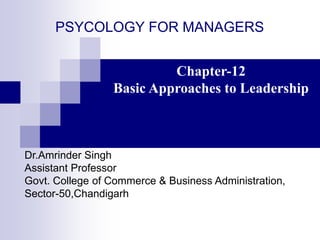
Basic Approaches to Leadership, Chapter-12- Organizational Behavior
- 1. PSYCOLOGY FOR MANAGERS Chapter-12 Basic Approaches to Leadership Dr.Amrinder Singh Assistant Professor Govt. College of Commerce & Business Administration, Sector-50,Chandigarh
- 2. What Is Leadership? Leadership The ability to influence a group toward the achievement of goals. Management Use of authority inherent in designated formal rank to obtain compliance from organizational members.
- 3. Trait Theories Leadership Traits: • Extraversion • Conscientiousness • Openness • Emotional Intelligence (qualified) Traits Theories of Leadership Theories that consider personality, social, physical, or intellectual traits to differentiate leaders from nonleaders.
- 4. Trait Theories Limitations: • No universal traits found that predict leadership in all situations. • Unclear evidence of the cause and effect of relationship of leadership and traits. • Better predictor of the appearance of leadership than distinguishing effective and ineffective leaders.
- 5. Trait Approach Traits (examples) – Extraversion – Conscientiousness – Openness Assumption: Leaders are born Goal: Select leaders Problems – Traits do not generalize across situations – Better at predicting leader emergence than leader effectiveness
- 6. Behavioral Theories • Behavioral theory: Leadership behaviors can be taught. Vs. Trait theory: Leaders are born, not made. Behavioral Theories of Leadership Theories proposing that specific behaviors differentiate leaders from nonleaders.
- 7. Behavioral Approach Ohio State Studies/U. of Michigan – Initiating Structure/Production Orientation – Consideration/Employee Orientation Assumption: Leaders can be trained Goal: Develop leaders Problem: Effective behaviors do not generalize across situations
- 8. Ohio State Studies Initiating Structure The extent to which a leader is likely to define and structure his or her role and those of sub- ordinates in the search for goal attainment. Consideration The extent to which a leader is likely to have job relationships characterized by mutual trust, respect for subordinate’s ideas, and regard for their feelings.
- 9. University of Michigan Studies Employee-Oriented Leader Emphasizing interpersonal relations; taking a personal interest in the needs of employees and accepting individual differences among members. Production-Oriented Leader One who emphasizes technical or task aspects of the job.
- 11. CONTINGENCY THEORIES All Consider the Situation – Fiedler’s Contingency Model – Cognitive Resource Theory – Hersey and Blanchard’s Situational Leadership Model – Path Goal Theory Assumptions underlying the different models: Fiedler: Leader’s style is fixed Other’s: Leader’s style can and should be changed
- 12. Fiedler Model Leader: Style is Fixed (Task oriented vs. Relationship oriented) Considers Situational Favorableness for Leader – Leader-member relations – Task structure – Position power Key Assumption – Leader must fit situation; options to accomplish this: – Select leader to fit situation – Change situation to fit leader
- 13. Fiedler’s Model: The Leader Assumption: Leader’s Style is Fixed & Can be Measured by the Least Preferred Co- Worker (LPC) Questionnaire Least Preferred Co-Worker (LPC) Questionnaire The way in which a leader will evaluate a co-worker that is not liked will indicate whether the leader is task- or relationship- oriented.
- 14. Fiedler’s Model: Defining the Situation Leader-Member Relations The degree of confidence, trust, and respect subordinates have in their leader. Task Structure The degree to which the job assignments are procedurized. Position Power Influence derived from one’s formal structural position in the organization; includes power to hire, fire, discipline, promote, and give salary increases.
- 15. Findings of the Fiedler Model • Category • Leader- Member Relations • Task Structure • Position Power I Good High Strong II Good High Low Weak Strong High Strong High Weak III IV V VI VII Good Good Poor Poor Poor Low Weak Low Strong VIII Poor Low Weak Good Poor Performance Relationship -Oriented Task-Oriented Favorable Moderate Unfavorable
- 16. Findings from Fiedler Model
- 17. Cognitive Resource Theory Research Support: • Less intelligent individuals perform better in leadership roles under high stress than do more intelligent individuals. • Less experienced people perform better in leadership roles under low stress than do more experienced people. Cognitive Resource Theory A theory of leadership that states that the level of stress in a situation is what impacts whether a leader’s intelligence or experience will be more effective.
- 18. Contingency Approach: Hersey & Blanchard Situational Model Considers Leader Behaviors (Task & Relationship) – Assumes Leaders CAN change their behaviors Considers Followers as the Situation – Follower Task maturity (ability & experience) – Follower Psychological maturity (willingness to take responsibility) Assumptions –Leaders can and should change their style to fit their followers’ degree of readiness (willingness and ability) –Therefore, it is possible to TRAIN leaders to better fit their style to their followers.
- 19. Hersey and Blanchard’s Situational Leadership Theory Situational Leadership Theory (SLT) A contingency theory that focuses on followers’ readiness; the more “ready” the followers (the more willing and able) the less the need for leader support and supervision. LOW Amount of Follower Readiness HIGH Amount of Leader Support & Supervision Required HIGH LOW
- 20. Leadership Styles and Follower Readiness (Hersey and Blanchard) Supportive Participative Monitoring Leadership Styles Directive High Task and Relationship Orientations WillingUnwilling Able Unable Follower Readiness
- 21. Leader–Member Exchange Theory Leader-Member Exchange (LMX) Theory •Leaders select certain followers to be “in” (favorites) Based on competence and/or compatibility & similarity to leader •“Exchanges” with these “In” followers will be higher quality than with those who are “Out” •RESULT: “In” subordinates will have higher performance ratings, less turnover, and greater job satisfaction
- 23. Path-Goal Theory Premise •Leader must help followers attaining goals and reduce roadblocks to success •Leaders must change behaviors to fit the situation (environmental contingencies & subordinate contingencies)
- 25. Leader-Participation Model Premise: •Rule based decision tree to guide leaders about when and when not to include subordinate participation in decision making •Considers 12 contingency variables to consider whether or not to include subordinates in decision making
